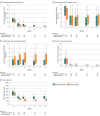Effect of Reduced-Dose vs High-Dose Glucocorticoids Added to Rituximab on Remission Induction in ANCA-Associated Vasculitis: A Randomized Clinical Trial
- PMID: 34061144
- PMCID: PMC8170547
- DOI: 10.1001/jama.2021.6615
Effect of Reduced-Dose vs High-Dose Glucocorticoids Added to Rituximab on Remission Induction in ANCA-Associated Vasculitis: A Randomized Clinical Trial
Abstract
Importance: The current standard induction therapy for antineutrophil cytoplasm antibody (ANCA)-associated vasculitis is the combination of high-dose glucocorticoids and cyclophosphamide or rituximab. Although these regimens have high remission rates, they are associated with considerable adverse events presumably due to high-dose glucocorticoids.
Objective: To compare efficacy and adverse events between a reduced-dose glucocorticoid plus rituximab regimen and the standard high-dose glucocorticoid plus rituximab regimen in remission induction of ANCA-associated vasculitis.
Design, setting, and participants: This was a phase 4, multicenter, open-label, randomized, noninferiority trial. A total of 140 patients with newly diagnosed ANCA-associated vasculitis without severe glomerulonephritis or alveolar hemorrhage were enrolled between November 2014 and June 2019 at 21 hospitals in Japan. Follow-up ended in December 2019.
Interventions: Patients were randomized to receive reduced-dose prednisolone (0.5 mg/kg/d) plus rituximab (375 mg/m2/wk, 4 doses) (n = 70) or high-dose prednisolone (1 mg/kg/d) plus rituximab (n = 70).
Main outcomes and measures: The primary end point was the remission rate at 6 months, and the prespecified noninferiority margin was -20 percentage points. There were 8 secondary efficacy outcomes and 6 secondary safety outcomes, including serious adverse events and infections.
Results: Among 140 patients who were randomized (median age, 73 years; 81 women [57.8%]), 134 (95.7%) completed the trial. At 6 months, 49 of 69 patients (71.0%) in the reduced-dose group and 45 of 65 patients (69.2%) in the high-dose group achieved remission with the protocolized treatments. The treatment difference of 1.8 percentage points (1-sided 97.5% CI, -13.7 to ∞) between the groups met the noninferiority criterion (P = .003 for noninferiority). Twenty-one serious adverse events occurred in 13 patients in the reduced-dose group (18.8%), while 41 occurred in 24 patients in the high-dose group (36.9%) (difference, -18.1% [95% CI, -33.0% to -3.2%]; P = .02). Seven serious infections occurred in 5 patients in the reduced-dose group (7.2%), while 20 occurred in 13 patients in the high-dose group (20.0%) (difference, -12.8% [95% CI, -24.2% to -1.3%]; P = .04).
Conclusions and relevance: Among patients with newly diagnosed ANCA-associated vasculitis without severe glomerulonephritis or alveolar hemorrhage, a reduced-dose glucocorticoid plus rituximab regimen was noninferior to a high-dose glucocorticoid plus rituximab regimen with regard to induction of disease remission at 6 months.
Trial registration: ClinicalTrials.gov Identifier: NCT02198248.
Conflict of interest statement
Figures


Comment in
-
Reduced-Dose vs High-Dose Glucocorticoids Added to Rituximab and Remission Induction in ANCA-Associated Vasculitis.JAMA. 2021 Oct 19;326(15):1536. doi: 10.1001/jama.2021.13873. JAMA. 2021. PMID: 34665208 No abstract available.
-
Reduced-Dose vs High-Dose Glucocorticoids Added to Rituximab and Remission Induction in ANCA-Associated Vasculitis.JAMA. 2021 Oct 19;326(15):1535-1536. doi: 10.1001/jama.2021.13867. JAMA. 2021. PMID: 34665209 No abstract available.
-
Reduced-Dose vs High-Dose Glucocorticoids Added to Rituximab and Remission Induction in ANCA-Associated Vasculitis.JAMA. 2021 Oct 19;326(15):1535. doi: 10.1001/jama.2021.13863. JAMA. 2021. PMID: 34665210 No abstract available.
References
-
- Harigai M, Nagasaka K, Amano K, et al. . 2017 Clinical practice guidelines of the Japan Research Committee of the Ministry of Health, Labour, and Welfare for Intractable Vasculitis for the management of ANCA-associated vasculitis. Mod Rheumatol. 2019;29(1):20-30. doi:10.1080/14397595.2018.1500437 - DOI - PubMed
Publication types
MeSH terms
Substances
Associated data
LinkOut - more resources
Full Text Sources
Other Literature Sources
Medical
Miscellaneous

